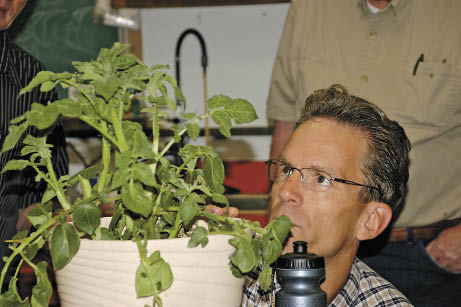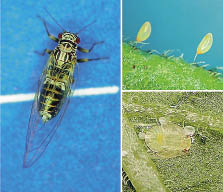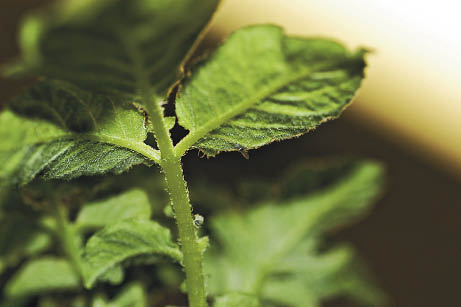 Outbreaks of potato psyllids (Bactericera cockerelli) are sporadic but have occurred suddenly and over vast areas.
Outbreaks of potato psyllids (Bactericera cockerelli) are sporadic but have occurred suddenly and over vast areas.
Dr. Andy Jensen, regional research director for the Idaho, Washington and Oregon potato commissions, spoke at the 45th annual Potato Conference in Pocatello, Idaho, on Jan. 23 about his studies of the insects overwintering in Idaho.
Psyllids are a common pest from the Rio Grande River Valley and north in the High Plains states. They are very small insects-the adults are about the size of the head of a pin, while the damaging nymph is closer in size to the point of a pin. The damage to plants is due to the injection of toxin produced by the insect into the plant during its feeding.
Psyllid Yellows & ZC
Damage is caused by a toxin that the immatures produce when they feed. The toxin causes a plant response known as psyllid yellows. Symptoms include an upward curling of leaflets nearest the stem on the top part of the plant. As the disease establishes itself, this symptom becomes more evident. Plant yellowing is the most common symptom. The yellowing (in some varieties, purpling) is initially found on the leaf edges.
Severe symptoms include overall yellowing with enlarged nodes, development of clusters of small leaves in the axillary buds that appear rosetted, and the formation of aerial tubers. Internodes are shortened and the plant eventually is dwarfed and appears pyramid shaped.
 The nature of psyllid yellows is unlike a virus. If the immature psyllids are removed from the plant, the progression of the disease will stop. As few as three or four nymphs per plant can produce symptoms, but more are needed for severe symptoms.
The nature of psyllid yellows is unlike a virus. If the immature psyllids are removed from the plant, the progression of the disease will stop. As few as three or four nymphs per plant can produce symptoms, but more are needed for severe symptoms.
Psyllids also vector an organism that is responsible for a condition known as zebra chip. The organism causes sugars to accumulate in areas of the tuber instead of starch; affected tubers have dark lines throughout the entire length. In chipping varieties, these areas turn black when the chips are fried, creating a black, striped effect that gives rise to the name zebra chip.
Infected plants produce fewer tubers. Yield losses from 20 to 50 percent have been reported.
"It was speculated that psyllids overwintered in the South and migrated north every year," Jensen says.
Outbreaks were thought to occur from flights of psyllids that migrate from southern states and Mexico. No one previously examined how psyllids arrive here or examined whether they can overwinter in the Northwest.
Bittersweet Finding
Jensen began his research in the winter of 2011 at three sites near where he lives in Eagle, Idaho. Sites included a roadside ditch and an irrigation ditch by Star and an irrigation ditch by Caldwell. He looked for the insects on bittersweet nightshade (Solanum dulcamara), generally described as a perennial vine and associated with waterways. Its flowers look similar to potato flowers.
Jensen found the plant survived the first frost in November. They were covered with aphids, as well as eggs, nymphs and adult psyllids.
In early February 2012, he collected cuttings and started a couple vines in a vase to see if they would break dormancy. He potted a couple vines after finding that they did.
In late February, Jensen started a colony in his house.
"Psyllids in the field were still viable and could produce the next generation in the lab," he says. "They went from egg-laying to adult in about four weeks."
Jensen found eggs by April 16 at the Caldwell site and large immature psyllids in early May.
"It proved they were wintering on this plant," he says. "They reproduce very fast."
Jensen conclusively demonstrated that this plant can host psyllids in the winter.
Further research must be done to find if other plants serve as overwintering hosts, Jensen said. And in what specific habitats do psyllids do best?
"We still don't know that," Jensen says. "Why do potato psyllids leave bittersweet nightshade? It's not obvious to me why they would leave and when."
Criminal Profile
 "Psyllids are everywhere," he adds. "It's important to have some notion of how to recognize the potato psyllid."
"Psyllids are everywhere," he adds. "It's important to have some notion of how to recognize the potato psyllid."
Potato psyllids look like small cicadas, about 2 millimeters long, and are related to aphids and leafhoppers. The adult has clear wings that rest roof-like over the body. Although predominantly black, the potato psyllid does possess white markings. The first abdominal segment shows a broad white band, the last segment has an inverted white "V." Adults have relatively long antennae. Psyllids jump quite readily when disturbed.
"You cannot recognize potato psyllids on yellow cards without magnification," Jensen said. "You have to use a microscope or something similar. Your naked eye will not see potato psyllids."
The football-shaped eggs are extremely small, slightly larger than leaf hairs, and on a short stalk. They are usually on the underside of the leaf along the edge and in the upper plant canopy. A 10X hand lens is required to see them.
 Psyllid nymphs look like immature soft scale or whiteflies. Unlike whiteflies, when disturbed, they move quite readily. They are flat and green with a fringe of short spines around the edge. The immatures go through five stages in as little as 13 days.
Psyllid nymphs look like immature soft scale or whiteflies. Unlike whiteflies, when disturbed, they move quite readily. They are flat and green with a fringe of short spines around the edge. The immatures go through five stages in as little as 13 days.
Use yellow sticky traps to detect the presence of potato psyllid and initiate leaf sampling. Currently, leaf sampling methods and thresholds are still being developed for this pest. It is recommended that the undersides of leaves be examined for nymphal stages. Because potato psyllid nymphs can be difficult to see on a potato leaf, planting a few pepper plants in the field can provide an easier way to detect the nymphs. Pepper plants have smooth leaves and are readily infested by the psyllids, making it easier to detect them on these crops than on potato plants. Keep records of your sampling results.
Psyllids used to be an occasional problem in California in certain years when they would migrate into the state from Mexico. In recent years, however, a more invasive form of the species has been found in California that has the ability to overwinter in parts of southern California. Potato psyllids are found on a yearly basis in California and have become a chronic problem.
Jensen's work has shown that potato psyllid is also a resident of the Northwest year-round. Various entomologists have observed potato psyllid in the Northwest back at least two decades. It remains unknown if long-distance migration from California and elsewhere contributes to the potato psyllid problem here.
Potato psyllid is native to North America. In the U.S., the potato psyllid has been reported in almost all states west of the Mississippi River.